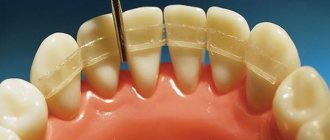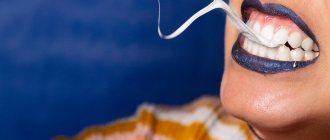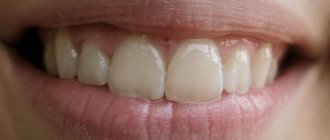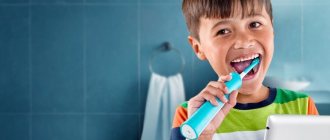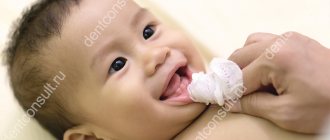Toothbrush material
Almost all modern brushes are made from nylon fibers. Previously, hygiene products were produced with bundles of animal hair. And the first prototypes of modern dental devices, invented in Ancient Egypt, generally consisted of disintegrated plant branches.
Dentists say that it is necessary to buy only synthetic brushes, explaining that natural materials are highly hygroscopic, and this leads to the proliferation of pathogenic bacteria in the villi of the brushes. Another disadvantage of natural bristles is excessive fragility, which leaves sharp edges that can injure the enamel.
What shape and size should a toothbrush be?
Toothbrushes are available in different sizes and head shapes. Please note the following features:
- The head should cover a maximum of 2-2.5 teeth. Only in this case will cleaning be effective. The head is too large and does not allow the bristles to penetrate into the interdental spaces.
- The length of the toothbrush head for children should be 18-25 mm, and for adults - 30 mm maximum. The child’s teeth are just growing, the jaw is not yet formed, so the large head can injure the gums. Small brushes are not useless for an adult, but brushing teeth with them is inconvenient. In addition, you will have to spend a lot of time on the procedure.
- The head should have a rounded shape to minimize the risk of injury to the oral mucosa.
- The area connecting the head with the handle must be movable so that the spring effect is triggered, due to which the pressure on the teeth and gums is reduced. Almost all modern brushes have a flexible neck to control pressure.
Brushes differ in the number of tufts. The larger the head, the more bristles it is equipped with. Children under 6 years old need to choose models with 23 bundles, teenagers - with 30-40, adults - with 45-55 bundles. People with braces should have a multi-tuft brush (more than 55). Their number is indicated on the packaging. It is not always possible to quickly find this parameter among the information written in small print. However, the quality of teeth cleaning depends on this, so it is better not to ignore this feature of the brush.
As for the handle, it just needs to be comfortable. It is advisable to choose a model with a rubberized coating that will not slip out of your hand.
What determines the choice of hardness level?
There are five degrees of hardness:
- very soft;
- soft;
- average;
- hard;
- very tough.
The choice of hardness level is influenced by various indicators:
- Age. Children are advised to buy toothbrushes with soft bristles . This requirement is due to the immaturity of dental tissues for several years after teething.
- Periodontal condition. For healthy gums, it is optimal to brush your teeth with a product of medium hardness. But if the patient notices bleeding, loose gums, mobility of teeth or ulcerations on soft tissues, then it is better to choose a soft toothbrush.
- Availability of prostheses and orthodontic structures. When wearing artificial products in the mouth, dentists recommend using devices with hard bristles to improve hygiene.
- Hyperesthesia. If your teeth are sensitive, cleaning with an ordinary brush can be a real torture. Products with soft bristles are suitable for such people.
What is the bristle material of a stiff brush?
It is worth noting! Toothbrushes come with natural or artificial bristles. Natural bristles are considered to be harmful to health.
It absorbs water well and creates excellent conditions for the cultivation of pathogenic bacteria. Dentists recommend using only products with artificial bristles.
When producing hard brushes, they are processed carefully: their edges are rounded, which prevents the risk of microtrauma during brushing .
The bristles are made from a modern and safe material – nylon.
Nylon fibers are polished, collected into bundles and evenly distributed over the working surface.
Brush hairs can be long or short. Short ones clean the chewing surface of the teeth, and long ones carefully clean the enamel and gums.
Keep in mind! According to the length and location of the bristles, brushes are divided into:
- single-level . The hairs are located at the same level parallel to each other and have the same length. Such products are ineffective and cannot cope with complex stains of tooth enamel;
- two- and three-level. They have great cleaning ability, clean the interdental spaces well, preventing the development of caries;
- multi-level. They remove dental plaque perfectly and are the most common.
Who should use a soft toothbrush?
A soft-bristled toothbrush is recommended:
- children under 10-12 years of age;
- people who suffer from bleeding when brushing their teeth;
- patients with diabetes mellitus;
- in case of blood clotting disorders;
- with third degree tooth mobility;
- with pathological abrasion and wedge-shaped defects;
- for periodontal diseases.
In addition to the degree of hardness, it is necessary to pay attention to the technique of cleaning the tooth surface. Sometimes the wrong technique can harm hard tissues.
Pros and cons of hard toothbrushes
The main feature of hard toothbrushes is dense bristles with a larger diameter. The packaging of such a brush must indicate the degree of hardness: “hard”, “x-hard” or “extra hard”. Some products may have a combined type of bristles, where one area is harder and the other is softer. The soft-hard toothbrush option may be suitable for people who need enhanced dental hygiene but also have sensitive gums. A classic toothbrush for daily hygiene has three or four rows; a smaller number of tufts suggests highly specialized use, for example, for cleaning orthodontic structures.
Are there any contraindications?
There is no list of contraindications for using a soft toothbrush, however, this does not mean that such a device cannot harm your teeth. The main disadvantage of soft bristles is that the degree of cleaning of the enamel is not good enough compared to normal or hard bristles.
Don't use a soft toothbrush:
- with a tendency to increased stone formation and accumulation of dental plaque;
- people who smoke;
- persons with a completely healthy oral cavity;
- with crowded teeth.
The use of soft bristles products for hygiene in such people is undesirable due to inadequate cleaning of the tooth surface and the likelihood of leaving plaque behind.
What is a medium hardness device?
A model with medium bristles is suitable for adults who do not have problems with teeth and gums.
Its advantages include :
- effective teeth cleaning;
- removing plaque from the tongue and cheeks (if there is a special silicone insert);
- versatility. It is suitable for any type of enamel.
Medium hardness dental products are the most common and are available in a variety of brands.
Regular or electric soft toothbrush?
An electric toothbrush allows you to provide better oral care. This is due to the small size of the working part, due to which it is able to penetrate into hard-to-reach areas of the oral cavity. In addition, the electric device performs not only reciprocating movements, but also circular ones, and modern models are supplemented with a pulsating rotation mode.
Children love to brush their teeth with electric brushes. This makes them feel more grown-up and also makes oral care a fun game. Electric dental devices often come with soft attachments that are intended for children.
There are situations where using a battery-powered brush can be harmful:
- Severe tooth mobility.
- Recovery period after surgery on soft tissues of the oral cavity.
- Stomatitis.
- Hypertrophic gingivitis.
- Malignant neoplasms.
If you are prone to abrasion of enamel, you should alternate between a soft manual toothbrush and an electric one.
Bristle material
Modern brushes are safe, convenient and effective devices that allow you to daily clean the surface of your teeth from food debris and soft deposits.
A few decades ago, hygiene products with natural bristles were extremely popular, but today everything has changed.
Almost all brushes have synthetic bristles.
It is impossible to find natural fibers among hard models, as they are particularly soft and brittle. Therefore, manufacturers have long switched to artificial materials.
Most often used:
- Nylon;
- Cetron;
- Polyurethane;
- Nerlon;
- Derlon.
These fibers are highly environmentally friendly and can be easily processed, including grinding the ends.
Review of the most popular models
The assortment of every manufacturer producing oral hygiene products includes models with soft tufts.
Let's consider the most popular:
- SPLAT Professional Sensitive - the villi are split into four parts, each of which is rounded to avoid injury. The bristles are impregnated with silver ions, which protect against bacterial attack on the teeth.
- LACALUT Sensitive - equipped with soft bristles that protect tooth enamel from damage and gently cleanse the oral cavity.
- Colgate 360 Sensitive Pro-Reliev - in addition to the fine bristles, there is a tongue brush on the back of the head. Among the tufts there are rubber cups that allow you to polish the tooth surface.
- Jordan Target Sensitive - has a small working part, which makes it possible to penetrate well into the back of the mouth. Ultrasoft bristles have a diameter of 0.01 mm.
How to determine hardness when purchasing?
to determine the rigidity of the device by its packaging. It must indicate the hardness indicator (medium, hard, extra hard).
Reference! The degree of rigidity is also determined by the diameter of the fibers. The larger their diameter, the stiffer the brush will be.
There are 4 degrees of bristle stiffness : hard, soft, medium (medium) and very soft. The best option is a model with hard pile, which is suitable for people of different age categories.
Hard brushes , in turn, are divided into :
- medium degree of hardness . They are the most popular and are used by most of the adult population. They are intended for a healthy oral cavity;
- hard . They are recommended for use by heavy smokers and coffee lovers. They are excellent at fighting plaque formation;
- super hard (extra hard). They are recommended for use when cleaning dentures and braces.
Most models are additionally equipped with silicone inserts on the back of the working head. They are intended for polishing teeth, cleaning the tongue or massaging gums.
Is it possible to make a toothbrush soft?
If your new brush is too hard for you, there are ways to soften your toothbrush:
- Place the head under running hot water.
- Gently knead the stubble with your fingers.
- Place the brush in a container of warm vinegar for half an hour.
Still, the most correct thing in this situation would be to purchase a new brush with different, softer bristles.
The choice of a toothbrush must be approached consciously, because the level of oral care, prevention of caries and gum disease depends on its quality. In order not to damage the enamel, it is necessary not only to use the right brush, but also to follow the technique of cleaning your teeth. And do not forget that each brush must be replaced after 3 months of use.
Author: Violeta Kudryavtseva, doctor, especially for Mama66.ru
How to choose?
When choosing a toothbrush, you need to start from its manufacturer.
Here you should read consumer reviews, find out as much information as possible about the brand itself, and listen to the advice of an experienced dentist.
When choosing a cleaning device, attention is paid to the following factors :
- cleaning head length . It must be at least 25 cm and have a smooth, rounded transition;
- degrees of hardness. The best option is a product with a medium degree of hardness;
- pen. It should be dense, thick and strong. As a rule, the handle is made of rubber, which makes it as comfortable to use as possible.
Important! After each use, the device must be rinsed well with water and dried. Personal hygiene items should be changed every 3-6 months.

